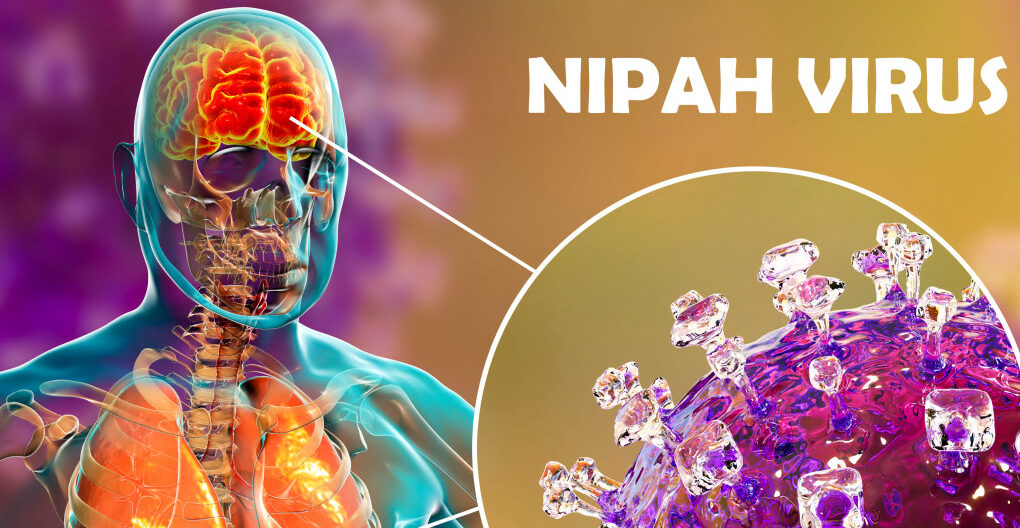The Nipah virus (NiV) and Hendra virus (HeV) are types of viruses that belong to the same group called Henipavirus. They are part of the Paramyxoviridae family. These viruses are naturally found in fruit bats, specifically bats known as Pteropus bats. Interestingly, these viruses don’t make the bats sick.
The way these viruses can infect people involves a few different ways:
- Contact with Bats: Sometimes, people can get infected if they come into contact with bats or substances from bats, like consuming date palm sap or fruits that might have bat saliva or urine in it. This has happened in outbreaks in places like Bangladesh and India, recently in kerala, for Nipah virus, but not so much for Hendra virus.
-
Contact with Infected Animals: The viruses can also be passed on to humans when they have contact with animals that act as middlemen. For Nipah virus, pigs are often the middlemen, and for Hendra virus, it’s usually horses. People might get infected through things like the urine or saliva of these sick animals.
-
Human-to-Human Spread: In some cases, these viruses can spread from one person to another. This has been seen more with Nipah virus, especially during outbreaks in Bangladesh. However, Hendra virus doesn’t seem to spread this way.
So, in simple terms, these viruses come from bats but usually infect people through animals like pigs or horses. Sometimes, people can also pass the virus to each other, but that happens more with Nipah virus than Hendra virus.
Pathology
Because there haven’t been many cases, we don’t fully understand how henipaviruses work in our bodies. But there are some things we’ve noticed when people get sick from these viruses.
Here’s what happens:
- Blood Vessel Problems: Henipaviruses can cause issues with our blood vessels. They make the walls of our blood vessels become inflamed and can block tiny blood vessels, causing tiny areas of damage (kind of like mini heart attacks). This happens especially in the brain but can also occur in other organs like the lungs.
-
Direct Infection: These viruses can also directly infect the stuff that makes up our organs, like the brain or lungs. This is a bit like the virus attacking these body parts directly.
-
Relapsed Encephalitis: Sometimes, even after someone seems to get better, they can have a second bout of swelling in the brain called encephalitis. We’re not exactly sure why this happens.
In simple terms, henipaviruses can mess up our blood vessels and directly infect our organs, especially the brain. They can also cause brain swelling again even after a person seems to be getting better, but we’re not sure why this happens yet.
Symptoms of Henipavirus Infections: What to Look For
When someone gets infected with Nipah virus (NiV), they might not show any symptoms at all. But when symptoms do appear, they can be quite serious. Here’s what you should watch out for:
Common Symptoms of NiV Infection:
-
Fever: It usually starts with a high body temperature.
-
Altered Mental Status: This means changes in thinking, like confusion.
-
Headache: You might have a severe headache.
-
Muscle Pain: You could feel pain in your muscles.
-
Weakness and Lethargy: You might feel very tired and weak.
-
Dizziness: You could feel like the world is spinning.
-
Nausea: You might feel like you’re going to throw up.
-
Vomiting: You could actually throw up.
Neurological Symptoms:
-
Seizures: These are sudden bursts of uncontrolled movements or shaking.
-
Areflexia: This means your reflexes don’t work like they should.
-
Hypotonia: Your muscles might become less tense than usual.
-
Autonomic Disturbance: Your body’s automatic functions, like heart rate and breathing, could act strangely.
-
Segmental Myoclonus: You might experience sudden, brief twitches or jerks in your muscles.
Breathing Problems:
Incubation Period:
This is the time between when you’re exposed to the virus and when you start showing symptoms. For NiV, this period can range from 4 to 18 days, but it could be as long as 2 months. If you’ve been in contact with someone who had NiV, symptoms might show up 6 to 11 days later.
Relapsing Encephalitis:
Sometimes, NiV can play tricks on your body. You might seem better after having it and then, months later, get sick again with neurological problems. This is called “relapsing encephalitis.” So, if you’ve had NiV before, doctors need to be careful if you show signs of a new neurological problem.
Identifying these infections isn’t easy, but it’s crucial. Doctors look at a patient’s symptoms, travel history, and exposure risk.
Initial Investigations: Understanding the Medical Tests
When someone is suspected of having a Henipavirus infection, doctors perform various medical tests to check for specific changes in the body that might indicate the presence of the virus.
Here’s what they do:
Blood Tests: Doctors take samples of blood for routine tests to look at different factors in your blood. These tests include Full Blood Count (FBC), Liver Function Tests (LFTs), Urea and Electrolytes, and Clotting Profiles. While these tests can show if something is wrong in your body, they don’t provide a clear answer for Henipavirus.
What They Might Find: In some cases of Henipavirus infections, there are changes in the blood that are not unique to these viruses. For example, they might see low platelet counts (thrombocytopenia) and increased liver enzyme levels (raised ALT,AST or ALP), especially with Nipah virus (NiV). The white blood cell counts are usually normal, but sometimes they might be low (leukopenia), which happens when you have fewer white blood cells than usual.
Chest Imaging: Doctors may take pictures of your chest using special machines. These images can show changes in your lungs. In some cases, they might see areas of the lungs that look different, like they’re filled with something. This is called consolidation or reticular changes. In severe cases, the lungs can become cloudy on the images, which is a sign of a condition called Acute Respiratory Distress Syndrome (ARDS).
More Tests: To be sure that it’s Henipavirus and not something else, doctors also check for malaria with blood films and perform blood and urine cultures to see if any other infections are causing similar symptoms.
Confirming the Diagnosis: After these initial tests, if doctors still suspect Henipavirus, they need more specific tests to confirm it. These tests depend on what’s available in the local medical facilities. The best way to confirm Henipavirus is through a test called serum neutralization. However, this test is risky to perform because Henipaviruses are very dangerous, so not many labs can do it. Instead, doctors usually use two common methods:
-
Blood and Spinal Fluid Tests: Doctors look for specific antibodies in your blood or spinal fluid that your body produces to fight the virus. Finding these antibodies can be a sign of Henipavirus infection.
-
RNA Testing: Another way to confirm Henipavirus is by detecting the genetic material of the virus itself using a test called reverse transcription-polymerase chain reaction (RT-PCR). This test is especially helpful when antibodies aren’t yet present in the body.
Lumbar Puncture: If you have neurological symptoms (like problems with your brain or nerves), doctors might perform a procedure called a lumbar puncture. This involves taking a sample of fluid from your spine to check for abnormalities. It helps to see if the virus has affected your nervous system.
Other Tests: Depending on your symptoms and where you’ve been, doctors may also check for other viral infections that could look similar, like herpes or varicella zoster virus. They’ll use additional tests based on your situation.
In summary, when doctors suspect a Henipavirus infection, they start with general tests to see if something’s wrong. Then, if they still think it’s Henipavirus, they do more specific tests to confirm it. These tests help them understand what’s happening in your body and how to best treat you.
Management
Facing a Nipah virus (NiV) infection can be daunting, but it’s crucial to know what measures are in place to tackle it effectively. Here’s a straightforward look at what’s involved:
Isolation: Stopping the Spread
NiV is contagious, so isolation is key. Infected individuals are kept in isolation with strict safety measures. This prevents the virus from spreading to others while allowing healthcare providers to offer specialized care.
Supportive Care: Your Ally
While we don’t have a specific cure for NiV, supportive care plays a vital role. It’s all about managing symptoms and providing comfort. This not only helps individuals feel better but also strengthens their immune system to fight the infection.
Exploring Treatment Options: What’s on the Table
Researchers are actively seeking treatments for NiV. One option being explored is Ribavirin, though its effectiveness is still uncertain. Other medications like Acyclovir, chloroquine, and ephrin-B2 are also under investigation.
Promising Avenues: New Hope
Two potential game-changers are Favipiravir and human monoclonal antibodies. Favipiravir, used for influenza in Japan, has shown promise in animal studies. Monoclonal antibodies are another exciting avenue for treatment.
Safe Return: Ensuring Well-being
Once a patient recovers from NiV, they can return home. However, a cautious approach is taken, with 21 additional days of isolation to ensure the virus is completely gone.
In essence, managing NiV involves isolation, supportive care, and ongoing research into treatments. While it’s a challenging situation, dedicated researchers and healthcare professionals are working tirelessly to protect us all.

